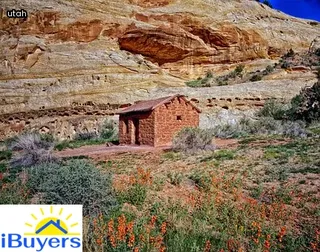Understanding the basics of Utah quit claim deeds is important for anyone who wants to transfer real estate in this state. A quit claim deed is a legal document used to transfer property or deed from one party (the grantor) to another (the grantee).
The process for completing a Utah quit claim deed is similar to those in other states, but there are some unique requirements that must be met. To begin, you'll need to have all parties involved present a valid form of identification and sign the deed in front of a notary public.
Next, you'll need to complete the necessary paperwork and obtain any required permits or licenses. Lastly, you'll need to file the deed with the county recorder's office within 30 days of completing it and pay any applicable fees.
With these steps in mind, you can confidently move forward with transferring real estate in Utah using a quit claim deed.

Completing a quitclaim deed on a house in Utah has numerous benefits for those looking to transfer property. A quitclaim deed is an efficient and straightforward method of transferring title from one person to another, and the process can be completed relatively quickly.
The grantor does not need to provide any warranties or guarantees with regards to the title; instead, it transfers whatever title the grantor has at the time of signing. In addition, there are no tax implications or other fees associated with quitclaim deeds, making them a cost-efficient option when compared to other types of transfers.
Furthermore, because they are considered simple documents they can be completed without involving an attorney or other third-party professionals. This makes them ideal for those who wish to complete their own real estate transactions without incurring additional costs.
Creating a legally binding Utah Quitclaim Deed is an important step when transferring property ownership. This document must be done correctly in order to properly transfer title and avoid any legal disputes.
Begin by downloading the form from the Utah State website or obtain it from a local title company or law firm. The grantor, or seller, will need to provide their name and address as well as the grantee’s, or buyer’s, name and address on the deed.
Then include a legal description of the property being transferred and make sure it matches the information on file with county records. Signatures of both parties are also required, along with witnesses to verify them if necessary.
Once complete, submit the deed to your county recorder’s office for filing in order to make it official. Following these steps will ensure that your quit claim deed is legally binding in Utah and can be used to successfully transfer title between two parties.

A quitclaim deed is a type of legal document used to transfer ownership of a piece of real estate in Utah. It is important to understand the requirements and limitations associated with such documents, as they will affect the rights and obligations of both the grantor (the individual transferring the property) and the grantee (the individual receiving the property).
In Utah, a quitclaim deed must include certain elements to be legally binding. These include an accurate description of the property, including its boundaries; names of all parties involved; signatures from both parties; and acknowledgment from a notary public.
Additionally, it is important to note that a quitclaim deed does not guarantee title or possession of the property – it simply conveys interest in it. Furthermore, any liens or encumbrances on the property remain with it upon transfer.
It is essential for individuals who are considering using a quitclaim deed in Utah to consult with an experienced real estate attorney before doing so. Understanding these requirements and limitations can help ensure that any transaction goes smoothly and meets all legal requirements.
It is important to properly prepare and file a Utah Quitclaim Deed in order to successfully transfer the title of a house. The process requires knowledge of the state laws, as well as specific steps to take.
Filing a Quitclaim Deed requires obtaining and filling out the appropriate forms, having them notarized, and filing them with the county recorder in Utah. Before beginning the process, make sure to obtain all necessary documents such as proof of ownership and identity from both parties involved in the deed.
A legal description of the property must be included on the deed form, so it is recommended to use an online mapping service to obtain an accurate description. To ensure accuracy, it is beneficial to have an attorney review all forms before they are submitted.
Once all forms are filled out correctly and notarized, they should be submitted to the county recorder's office along with any applicable fees. Following these guidelines will help ensure that a Utah Quitclaim Deed is completed properly for a successful house title transfer.

When it comes to drafting a Quitclaim Deed for a property in Utah, it is important to ensure that the template you use is accurate and up-to-date. Many online sources offer templates for free, but it is always best practice to check with your county's specific regulations before choosing one.
It can also be beneficial to consult with a lawyer or other legal professional who specializes in real estate law, as they will likely have advice on which template would be the most appropriate. Additionally, searching for an example of another deed within your area can provide helpful guidance.
It may even be worth asking around with family and friends who have recently completed the process to see if they had any advice or tips on where to find a suitable template. Finally, look into local resources such as title companies or land surveying offices, as they may have helpful information on the correct forms and documents needed when filing a Quitclaim Deed in Utah.
It is important to include certain provisions in your Utah Quitclaim Deed when completing a transaction on a house. The document must be prepared correctly and accurately according to the laws of the state of Utah.
The deed should include the current owner's name and address, as well as that of the new owner or grantee. It should also include an accurate description of the property, including its street address, lot number and parcel ID number if available.
Additionally, the deed should list any easements or rights of way associated with the property that may affect its use or value. Finally, it is essential to include a legal description of the property's boundaries in order for it to be legally valid.
All these provisions must be properly included in the deed in order to complete a quit claim transfer on a house in Utah.

When filing a Utah Quitclaim Deed, there are several common misconceptions that should be addressed. First, many assume that the process is complicated and time consuming.
However, it can actually be completed in a matter of minutes with the right forms and paperwork. Second, some may think that filing a Quitclaim Deed removes all liens on the property but this is not necessarily true; it only transfers ownership from one party to another without any guarantees or warranties about debt or title issues.
Third, some people assume that filing a Quitclaim Deed automatically makes them responsible for all mortgages on the property but this is not always the case as existing loans remain with previous owners unless otherwise specified in the deed. Understanding these misconceptions can help ensure that you complete your Utah Quitclaim Deed properly and quickly.
Mistakes and omissions on a quitclaim deed can be a serious issue when transferring property, particularly in the state of Utah. To rectify such errors, it is important to understand what paperwork and materials are necessary for completing the deed correctly.
Having an understanding of Utah's rules and regulations surrounding quitclaim deeds is essential for ensuring that mistakes or omissions do not lead to costly complications down the line. Before beginning any paperwork, you will want to consult with an experienced real estate attorney who can review your agreement and advise you as to how best to proceed.
Once any necessary changes have been made, both parties should sign the revised documents and submit them to their respective county recorder's office for recording. This process may require additional fees for filing or amending documents, depending on the situation.
Lastly, it is important to keep copies of all paperwork so that there is a record of any alterations that may have been made in order to rectify mistakes or omissions on your Utah quitclaim deed.

When it comes to creating a valid Utah Quitclaim Deed, there are a variety of helpful resources available outside of the step-by-step guide. These additional resources can provide useful information related to the legal requirements and processes associated with forming a Quitclaim Deed in Utah.
For example, potential homeowners should reach out to their local county recorder’s office for further instructions on how to correctly prepare and file a Quitclaim Deed. Additionally, consulting an attorney who specializes in real estate law can provide insight into the specific details surrounding the formation of a Quitclaim Deed in Utah.
Furthermore, there are several online resources that provide more detailed instruction as well as templates for creating a legally binding Quitclaim Deed. Exploring these additional resources is key to successfully completing a valid Utah Quitclaim Deed.
The process of completing a quit claim deed on a house in Utah can be complicated, especially when taking into account local laws and regulations that may apply. Most states have specific rules and regulations regarding the registration of deeds, with Utah being no exception.
It is important to understand these regulations, as they could affect the outcome of the quit claim deed. Additionally, there may be certain filing fees or taxes that need to be paid before you can transfer ownership of the property to another individual.
Depending on where the property is located, there may also be zoning restrictions that must be taken into consideration. Furthermore, some counties in Utah require additional documentation for quitclaim deeds such as affidavits or death certificates if one of the parties involved has passed away.
Taking the time to familiarize yourself with the laws and regulations applicable to your area will ensure that you are able to properly complete and register a quit claim deed without any issues.

If you are in the process of completing a quit claim deed on a house in Utah, there are several steps that must be taken to ensure that your quit claim is processed correctly and efficiently. First, you should gather all relevant documents including your deed, title, and any other records pertaining to the property.
Next, you will need to complete the quit claim document which can usually be found online or at a local county office. Be sure to fill out all required fields accurately and completely.
Once the form is completed, it must be signed by both parties involved in the transaction and notarized by an authorized individual. Finally, you will need to submit your completed quit claim deed along with any applicable fees or taxes to the county office for processing.
Following these steps will help ensure that your Utah quit claim is processed correctly and efficiently so that you can move forward with transferring ownership of the property.
One of the most important steps to successfully creating and using a valid Utah Quit Claim Deed for a house is to ensure it meets all additional accessibility requirements. In order to do this, the deed must be completed correctly in accordance with the laws of Utah.
This includes completing any additional forms that may be required, such as an affidavit of title or property description sheet. It is essential to make sure all information provided on these forms is accurate and up-to-date.
Additionally, any witnesses who are required to sign the deed must also be present during its completion and execution. Furthermore, there are certain language requirements that must be included in the deed itself in order for it to be considered valid.
These include specifying the grantor and grantee's name, address, and legal description of the property being transferred. Finally, each party involved in the transaction must sign and date the document for it to take effect.
By following these steps closely, anyone looking to complete a quit claim deed on a house in Utah can ensure its validity and success.

When drafting or filing a Utah Quit Claim, there are some common red flags that you should be aware of. First and foremost, make sure that all signatures are either notarized or witnessed in accordance with the law.
Additionally, any discrepancies between documents or inconsistencies in the deed itself can lead to issues down the line and should be avoided. Make sure to check for typos as well, since even small errors can have a big impact on legal validity.
Furthermore, it is essential to ensure that all parties involved are listed on the deed and that any necessary information is included such as names, addresses and property details. Finally, if you need assistance with your Quit Claim Deed it is best to consult with a qualified attorney before proceeding.
When completing a quit claim deed in Utah, you will need to provide additional documents in order to properly execute the process. These documents can include a deed of trust, mortgage, title policy, and other items that relate to the property itself.
The first step is to check with the county recorder's office where the property is located as they can provide a comprehensive list of what is needed in order to complete your quit claim deed. Additionally, speaking with an attorney or real estate professional familiar with Utah real estate laws can also help you ensure you have all the necessary documentation for your situation.
Furthermore, researching online for local resources such as websites or articles discussing quit claims in Utah can be beneficial when looking for more information related to documentation requirements. Gathering these documents in advance will make it easier and faster to complete your quit claim deed when ready.

Completing a quit claim deed in Utah can be a complicated process, especially if you're not sure of the legal requirements and paperwork that needs to be completed. Fortunately, there are professional services available that can provide assistance with this task.
An experienced lawyer or title company can ensure that your quit claim deed forms are properly filled out and submitted, so that the transfer of property ownership is legally binding. With their help, you can rest assured that the process will be done correctly and efficiently.
In addition to these professionals, you may also wish to consider searching for an online provider who specializes in preparing quit claim deeds in Utah. These companies typically offer convenient solutions for completing necessary paperwork quickly and accurately, as well as providing helpful advice about how to navigate the process successfully.
When selling a house in Utah, you may be considering alternative methods for establishing title ownership. One such option is to complete a quitclaim deed.
This document transfers any and all interest in the property from the current owner to the buyer. A quitclaim deed is an easy and efficient way to transfer title, but there are certain steps that must be followed in order to ensure that it is done correctly in Utah.
Completing a quitclaim deed requires following specific guidelines established by the state of Utah while also ensuring that all documents are filled out accurately and completely before filing with the local county recorder's office. Understanding how to properly complete a Quit Claim Deed on a House in Utah can help prevent costly mistakes and guarantee that title ownership is successfully transferred.

Completing a quit claim deed on a house in Utah can be a complicated process, but it doesn't have to be. To ensure your quit claim deed is finalized properly, there are certain steps you should follow.
Firstly, make sure you have the appropriate documents and paperwork prepared, such as the deed itself, a copy of the original title, and any other relevant information about the property. Additionally, you need to include all parties involved in the transaction and make sure each has signed the deed.
You will also need to complete some paperwork at the county recorder's office and provide proof of identification for all parties listed on the document. Furthermore, it is important to pay attention to any fees associated with recording or filing your quit claim deed and make sure they are paid off before finalizing it.
Finally, make sure to retain copies of your completed quit claim deed for personal records. Following these steps will help guarantee that your UT quit claim deed is finalized properly and without any issues.
Completing a quit claim deed on a house in Utah can be confusing, and many people have questions about the process. A quit claim deed is a legal document used to transfer ownership of property without any warranties or guarantees that the title is clear.
It’s important to understand the necessary steps to complete a quit claim deed properly in order to make sure that any transfer of property is done correctly. Some of the most frequently asked questions concerning Utah quit claim deeds include: who needs to sign the deed, what information should be included in the deed, how do you file it with the courts, and what happens after the filing? All of these questions are important for those looking to complete a quit claim deed on a house in Utah.
Knowing who needs to sign and providing all required information are key steps for completing the process correctly. Filing with the appropriate court ensures your paperwork will be accepted by state officials.
Finally, understanding what happens after filing helps ensure that all necessary steps have been completed for successful transfer of ownership rights.

A quitclaim deed is a type of legal document used to transfer the ownership of a property. It is different from other types of deeds in that it does not guarantee any warranties or guarantees on the title of the property.
In Utah, a quitclaim deed must be notarized and filed with the county Recorder's office in order to be valid. This step-by-step guide will provide an overview of the process for completing a quitclaim deed on a house in Utah, comparing it with other types of deeds commonly used in real estate transactions.
Other types of deeds such as warranty deed and special warranty deed are more commonly used as they provide assurance about the title of the property as well as granting warranties. A warranty deed typically contains language that transfers good title from one party to another, while a special warranty deed only provides assurance that there has been no activity on the title since it was transferred by the grantor.
In comparison, a quitclaim deed does not provide any assurances or warranties concerning its title and simply transfers whatever interest the grantor has in the property.
When it comes to completing a quit claim deed on a house in Utah, there are some key components necessary for the process. To begin, you will need a valid form of identification.
In addition, you must have proof of ownership of the property by way of title deed or other legal documents. You will also need to provide the deed itself which must include the names and signatures of all parties involved as well as any additional information such as address and legal description of the property.
In addition, if there is more than one party involved in the transaction, each will need to sign a notarized affidavit affirming that they are willing participants in the agreement. Lastly, you may be required to pay certain filing fees associated with transferring title depending on your local county regulations.
It is important to research these regulations ahead of time so that you can be prepared when it comes time to complete your quit claim deed.

Transferring a deed in Utah can be accomplished by completing a Quit Claim Deed. A Quit Claim Deed is a legal document that transfers ownership and interest in real property from one person or entity to another.
In order to complete the transfer, you must follow certain steps. First, obtain the Quit Claim Deed form from your county recorder’s office.
Next, fill out the document with the correct information including the grantor (seller) and grantee (buyer) name and address as well as details about the real estate being transferred. After filling out the form, both parties involved in the transaction must sign it in front of a notary public.
Lastly, submit your completed document to your local county recorder’s office for filing. Following these steps will help ensure that you properly transfer ownership of a house in Utah using a Quit Claim Deed.
Utah Code 57-1-13 is the applicable code for a quit claim deed on a house in Utah. This code outlines the legal process and requirements that must be followed in order to complete a quit claim deed on a house in the state of Utah.
It is important to understand what this code entails and how it applies to the process of completing a quit claim deed on a house in Utah in order to ensure that all legal requirements are met. The first step is to obtain the appropriate forms, which can be obtained from either an attorney or title company.
After obtaining these forms, they must then be properly filled out according to the instructions provided by the relevant authorities. Once completed, these forms must then be signed by both parties involved in the transaction and notarized.
Finally, the completed documents must be filed with either the county recorder's office or other designated authority as specified in Utah Code 57-1-13. Following these steps will ensure that a quit claim deed on a house in Utah is legally binding and valid.
If you need a copy of your house title in Utah, the first step is to complete a Quit Claim Deed. A Quit Claim Deed is a legal document used to transfer ownership of real estate from one person or entity to another.
To complete the deed, you will need to know the current owner and the new owner’s information, as well as any outstanding liens or mortgages on the property. Once you have gathered this information, you can fill out the form online or at your local county recorder’s office.
You will also need to provide documentation that proves you are legally able to transfer title, such as a valid driver’s license or passport. After filing the form with your county recorder’s office, they will provide you with a copy of your house title.
It is important to note that Quit Claim Deeds are not always accepted in Utah so it is wise to consult an attorney before filing.
A: In Utah, when one spouse is selling a house using a quit claim deed, they must ensure that the property rights and conveyance are properly transferred to the new owner. This includes providing evidence of the marital status of both spouses involved in the transaction.
A: In Utah, a quit claim deed can be used by divorced spouses to transfer ownership of a house. The spouse transferring the property rights must sign the deed and have it notarized before filing it with the county recorder’s office. The recipient of the property must also have their signature notarized on the deed. After filing, the county recorder will issue a receipt for the deed and the transfer will become effective once recorded.

A: When transferring a property by quit claim deed between spouses in Utah, the transfer should generally be done without any tax implications as long as both spouses are US citizens and are living together. If one or both parties are not US citizens, then the transfer may be subject to gift tax rules. Additionally, if the property is held in a living trust, it is important to consult with an attorney for compliance with applicable laws and regulations.
A: Joint tenancy is when two or more people are equal owners of a property, with both having an equal right to possession. Co-tenancy is when two or more individuals have an undivided interest in the same property. Tenants in common describes a situation where two or more people hold separate interests in the same property and can sell their respective interests without the consent of other owners. Tenancy by the entirety grants ownership of property exclusively to married couples as one individual entity rather than two separate entities. When applying a quit claim deed to a house in Utah, it may be necessary to identify which type of ownership arrangement is being used between the parties transferring title.
A: A quit claim deed on a house in Utah should be prepared and signed in accordance with state law. The parties should each have their own attorney to review the document, and it should be recorded with the county recorder where the property is located. In Utah, a quit claim deed must contain the grantor’s name, grantee’s name, legal description of the property, consideration (price), date of signature, signature of grantor(s), and signature of witness(es). The document must then be notarized before being submitted to the county recorder for recording.

A: The LLC must first file the deed in the office of the county recorder in Utah County, specifying all parties involved and the consideration given for the transfer of ownership. The deed must include two witnesses who can verify that all parties are consenting to the transfer. The deed should then be signed and notarized by both parties, at which point it is legally valid and enforceable.
A: To complete a quit claim deed on a house in Utah, first you will need to obtain a quit claim deed form from your local county recorder's office. Next, fill out the form with details such as the grantor and grantee names, legal description of the property, and consideration amount. After that, have the form signed by both parties and notarized. Finally, record the document at your local county recorder’s office to officially transfer property rights.
A: When executing a quit claim deed for a house in Utah, the potential liabilities can include incorrect descriptions of the property, unrecorded liens or other encumbrances, and undisclosed heirs. To protect against these liabilities, it is important to conduct a thorough title search and obtain title insurance prior to transferring ownership.
A: When transferring ownership of a house in Utah via a quit claim deed, heirs are typically not involved. Gifts may be used to transfer ownership, however the gift must be legally documented and registered with the county where the property is located. Contracts may also be used when transferring ownership of the house through either joint tenancy or tenancy in common, and they must include the details of the transfer such as signatures from both parties and any other related information.